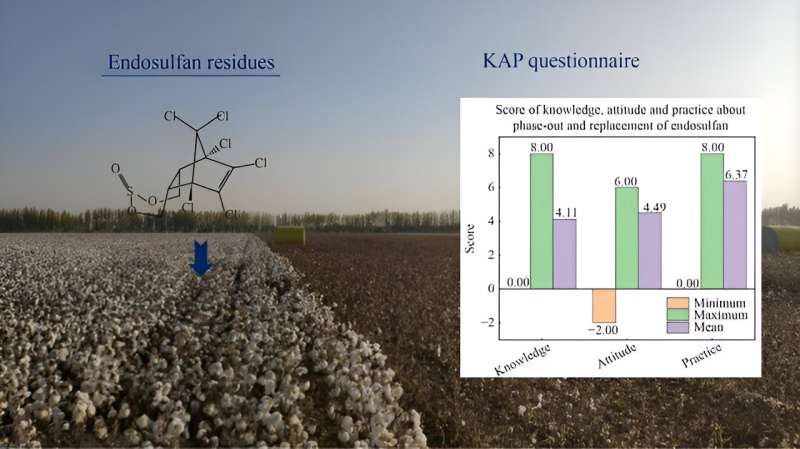This article has been reviewed according to Science X's editorial process and policies. Editors have highlighted the following attributes while ensuring the content's credibility:
fact-checked
proofread
Assessing endosulfan residues and farmer response post-ban in China's cotton regions

Endosulfan, a broad-spectrum organochlorine pesticide, was widely used in agricultural sectors, including cotton farming, due to its effectiveness against pests. However, due to its environmental persistence and potential health risks, its production and use have been banned in China since March 2019.
A study published in Frontiers of Environmental Science & Engineering on 15 December 2023 examines the levels of endosulfan residues in cotton fields of Northwest China and assesses the knowledge, attitudes, and practices (KAP) of local farmers regarding the pesticide's phase-out.
This study embarked on a comprehensive investigation into the prevalence of endosulfan residues in the soils of cotton fields across Northwest China, post its official ban. By collecting and analyzing soil samples from 91 distinct fields, the research aimed to quantify the residual presence of this once widely-used pesticide, offering insights into its environmental persistence.
Concurrently, a survey involving 291 cotton farmers was conducted to assess their knowledge, attitudes, and practices (KAP) regarding the discontinuation of endosulfan and their transition to alternative pest management strategies.
This dual approach not only shed light on the effectiveness of the ban in reducing pesticide residues but also highlighted the varying degrees of awareness and readiness among farmers to adopt safer, environmentally friendly pest control methods.
Yang Zhang, the study's co-author, emphasized the importance of bridging the knowledge gap among farmers to ensure the effective adoption of safer pest control alternatives, safeguarding both the environment and public health.
The study's results emphasize the importance of improving farmer education and creating accessible, effective alternatives for pest management. It suggests ongoing pesticide residue monitoring and the promotion of sustainable farming practices.
Contributing to the broader research on pesticide impact and sustainable agriculture, it provides valuable insights for policymakers, researchers, and the agricultural sector on handling legacy pesticides and enhancing environmental safety.
More information: Shuyan Zhou et al, Endosulfan residues and farmers' replacement behaviors of endosulfan in the north-west inland cotton region, Frontiers of Environmental Science & Engineering (2023). DOI: 10.1007/s11783-024-1803-8
Provided by TranSpread





















